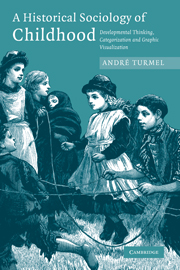 A Historical Sociology of Childhood
A Historical Sociology of Childhood Book contents
- Frontmatter
- Contents
- List of illustrations
- Acknowledgements
- Introduction
- 1 Children in the collective
- 2 Graphs, charts and tabulations: the textual inscription of children
- 3 Social technologies: regulation and resistance
- 4 The normal child: translation and circulation
- 5 Developmental thinking as a cognitive form
- Conclusion
- Appendix
- Bibliography
- Index
2 - Graphs, charts and tabulations: the textual inscription of children
Published online by Cambridge University Press: 22 September 2009
- Frontmatter
- Contents
- List of illustrations
- Acknowledgements
- Introduction
- 1 Children in the collective
- 2 Graphs, charts and tabulations: the textual inscription of children
- 3 Social technologies: regulation and resistance
- 4 The normal child: translation and circulation
- 5 Developmental thinking as a cognitive form
- Conclusion
- Appendix
- Bibliography
- Index
Summary
British historian C. Steedman points out that, during the nineteenth century, the child figure and the very idea of childhood were sustained in literature and in science above all (Steedman 1995). In this latter case, buoyant new fields and new technologies of investigation spread throughout the century and some scientists grasped these opportunities, particularly in the emergent domain of childhood research. From the outset, one is struck by the constant, steady and hence huge presence of graphs, charts, tabulations and the like in scientific journals and books related in one way or another to the empirical study of children. These original ways of observing the child from within a scientific discourse are connected with the increase of knowledge, notably technical knowledge, about childhood. The complex of descriptions, vocabularies and visual depictions evolved in such fields as anthropometry, hygiene, paediatrics and psychology that researched the child.
First, I shall propose that a growing body of scientific texts became available, initially in specialized circles and afterwards to a larger public, alongside the enormous advice literature provided by the welfare groups. This specific discourse involved a textual inscription of children whose form is relatively different from the previous ones. The second purpose of this chapter is to consider the radical novelty introduced by this specific textual inscription of children in the form of graphs and charts etc.
- Type
- Chapter
- Information
- A Historical Sociology of ChildhoodDevelopmental Thinking, Categorization and Graphic Visualization, pp. 66 - 114Publisher: Cambridge University PressPrint publication year: 2008


